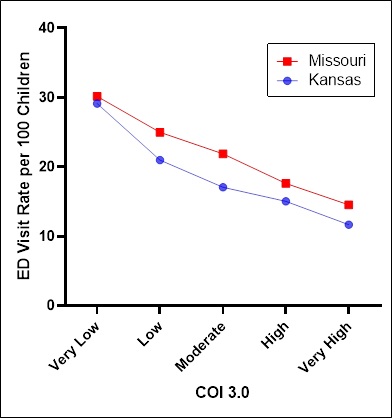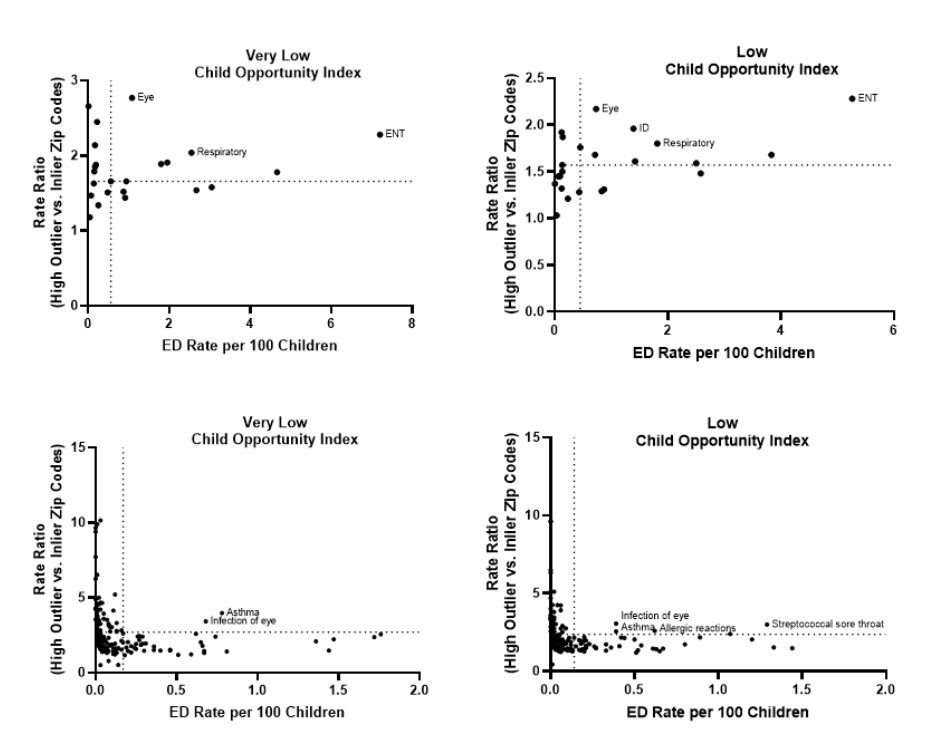Emergency Medicine 1
Session: Emergency Medicine 1
411 - Emergency Department Utilization for Children by Levels of Community Advantage
Friday, April 25, 2025
5:30pm - 7:45pm HST
Publication Number: 411.4724
Katherine Randolph, Children's Mercy Hospitals and Clinics, Mission, KS, United States; Chris Kennedy, Children's Mercy Hospitals and Clinics, kansas city, MO, United States; Jennifer Watts, Children's Mercy Kansas City, Kansas City, MO, United States; Matthew Hall, Children's Hospital Association, Lenexa, KS, United States
- KR
Kayle Randolph, DO (she/her/hers)
Pediatric Emergency Medicine Fellow
Children's Mercy Hospitals and Clinics
Mission, Kansas, United States
Presenting Author(s)
Background: Children with higher social deprivation have higher emergency department (ED) utilization. The Childhood Opportunity Index (COI) is a validated multidimensional measure of community advantage which includes access to resources and healthy neighborhood factors. Educational priorities are frequently not tied to risk data.
Objective: This study aimed to identify zip codes with higher-than-expected ED utilization by diagnoses to prioritize the development of educational initiatives for hospitals, emergency medical services, pediatrician offices, and the community.
Design/Methods: We performed a population-based study of children aged 0-17 years who presented to an ED in Kansas or Missouri in 2023 using census data via the Hospital Industry Database Institute. The relationship between levels of COI and ED utilization was modeled, and inlier home zip codes (average utilizers) and high outlier zip codes (higher than average utilizers) were identified for each COI level. Rate ratios (RR) were used to quantify differences in ED rates between inlier and outlier zip codes. Prevalence and RR were calculated for each Major Diagnostic Category (MDC) and for the top 20 most common conditions within each MDC. Priority conditions were defined as those with prevalence and statistically significant RR above their respective medians.
Results: There were 2,351,413 ED visits from children in 1,617 zip codes (17.3% Very Low COI, 36.8% Low COI) included. ED utilization rates decreased linearly as COI increased (p <.001). After modeling, there were 69 (25.2%) Very Low and 135 (22.6%) Low COI zip codes identified as high outliers of ED utilization. In Very Low and Low COI zip codes, eye, respiratory, and ear nose and throat (ENT) conditions had prevalence and RRs above their medians. Other more specific diagnoses that met these priority criteria include: inflammation/infection of the eye, otitis media, streptococcal sore throat, and asthma.
Conclusion(s): Our data corroborated the established relationship between COI and ED utilization among children. Infections of the ear nose and throat, eye and asthma were common drivers in low and very low COI zip codes (see Table 1). The high frequency ED use for non-emergent diagnoses re-emphasizes and re-focuses on access to care for families in low and very low COI levels. This data can be used to target educational initiatives including hospital, emergency medical services and pediatrician offices on best care practices and pediatric readiness, in addition to community education on appropriate ED visits.
High Priority Diagnoses in Low and Very Low COI

ED Utilization by COI
 Lower Childhood Opportunity Index (COI) was associated with higher Emergency Department (ED) Utilization
Lower Childhood Opportunity Index (COI) was associated with higher Emergency Department (ED) UtilizationHighest ED Utilizers by MDC and Diagnosis
 Upper two graphs depict highest outlying diagnoses by Major Diagnostic Criteria (MDC), from Very Low and Low COI groups.
Upper two graphs depict highest outlying diagnoses by Major Diagnostic Criteria (MDC), from Very Low and Low COI groups.Lower two graphs depict highest outlying specific diagnoses, from Very Low and Low COI groups.

